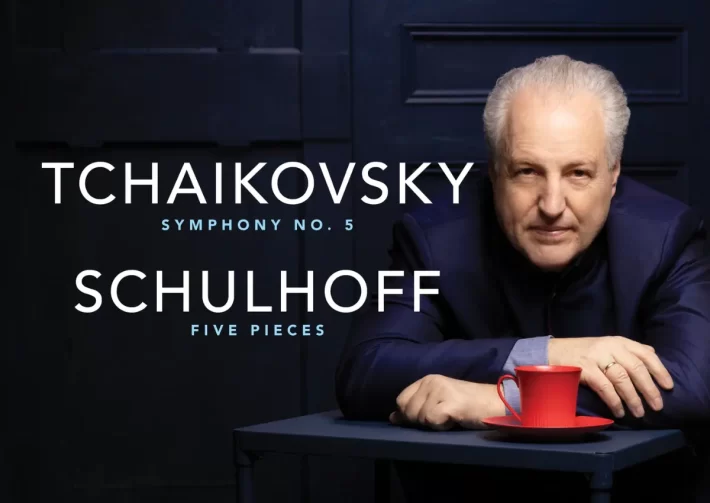By my count, this is the nineteenth release by this partnership: 5 on Exton and 14 on Reference Recordings. Programming, for the most part, has featured standard Romantic and 20th-Century repertoire, yet the uniform excellence of the recordings has ensured that many of the albums earn a place on lists of recommended recordings. This is Reference’s third Pittsburgh/Honeck Tchaikovsky release: I found the ‘Pathétique’ profoundly moving but was disappointed in their recording of the fourth (see review) because of unnecessary tempo and dynamic tinkering. This latest release, however, is their best Tchaikovsky yet and indeed one of the finest performances of the fifth I have ever heard.
Interestingly these forces have recorded the fifth symphony before. That release, on Exton, captures the 2006 live performance where conductor and orchestra first met. The chemistry between conductor and orchestra is already apparent, and Honeck’s interpretation is very much the same, but sometimes the orchestra struggles to do everything Honeck wants. Some tempo changes feel awkward, phrasing can seem mannered, and a few orchestral balances are askew. Sixteen years later the Pittsburgh players know exactly what Honeck wants and how to give it to him. Phrasing has great elasticity that nevertheless always sounds natural and organic. Dynamic control is masterly, and Honeck limits his score tinkering to a few instances that prove rather effective.
Honeck is a romantic, subjective interpreter, conducting the score with an operatic intensity. The Pittsburgh brass are superb, offering gentle harmonic cushioning one minute, roaring with a ferocity worthy of Mravinsky and Svetlanov’s orchestras the next. The richly burnished string playing is searingly lyrical and dazzlingly articulate by turns. Woodwinds have plenty of character, the dialogues between themselves and the strings in the second movement particularly poignant. This is astounding orchestral playing with a freshness and enthusiasm that suggests the players are discovering the music for the first time, though we know that is not the case. A listing of the many highlights is impossible, but I would urge readers to sample the opening of the second movement: how beautifully the orchestra sets the scene for the solo horn, played with such tenderness and creamy tone by principal horn William Caballero. (All credit to Reference Recordings for always listing the orchestral roster in the liner notes.)
Related Posts
- Review: Tchaikovsky – Symphony No. 4, Leshnoff – Double concerto – Honeck
- Review: Brahms – Symphony No. 4 – Pittsburgh Symphony Orchestra, Manfred Honeck
- Review: Beethoven – Symphony No. 9 – Pittsburgh Symphony Orchestra, Manfred Honeck
This is not an interpretation for those seeking emotional restraint or focus on the music’s architecture. Indeed, there are moments when the rubato is so extreme one fears losing any sense of structure. This performance is an emotional rollercoaster, the struggle with fate almost ceaseless (though the gracefulness of the third movement is a welcome respite), so that when the last movement’s victorious march arrives it feels particularly hard won. My primary recommendations for this work have been Gatti (RPO/Harmonia Mundi), Karajan (BPO/EMI) and Gergiev’s first recording with the Vienna Philharmonic (Philips). This new release now joins, and perhaps leads that list.
The companion piece, a new orchestration of Erwin Schulhoff’s ‘Five Pieces for String Quartet’ by Manfred Honeck and Tomás Ille, makes the album even more desirable. An Austro-Czech composer and pianist, Schulhoff’s increasingly successful career was cut short when, as both a Jew and Soviet citizen, he was arrested and transferred to a Bavarian Concentration Camp in Wülzburg, where he died of tuberculosis on August 18, 1942. His ‘Five Pieces’ are short, character pieces, each based on a particular type of dance. Schulhoff’s original work has a frisky playfulness that is nevertheless intimate and personal, whereas in its incarnation (for a rather large late Romantic orchestra) the playfulness turns darker, more menacing. Different though it may be, the skillful orchestration reveals a strong kinship to the sound world of Mahler, Schrecker, Ullmann, and Zemlinsky. The playing has a white-hear intensity that draws one in, and I hope other orchestras will take this set into their concert programs.
Ancillary materials, including 16-pages of notes by the conductor, are outstanding. It must have been quite enthralling to hear these performances in person, but thankfully Reference was present to make these superlative recordings – long may this partnership continue.

Tchaikovsky – Symphony No. 5
Schulhoff: Five Pieces for String Quartet (Arr. Honeck/Ille)
Pittsburgh Symphony Orchestra
Manfred Honeck – Conductor
Reference Recordings FR-752SACD
Recommended Comparisons
Mravinsky | Svetlanov | Karajan | Steinberg
Included with an Apple Music subscription:
Read more classical music reviews or visit The Classic Review Amazon store
Follow Us and Comment:
[wd_hustle id=”HustlePostEmbed” type=”embedded”]











